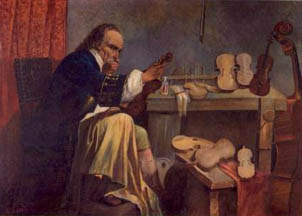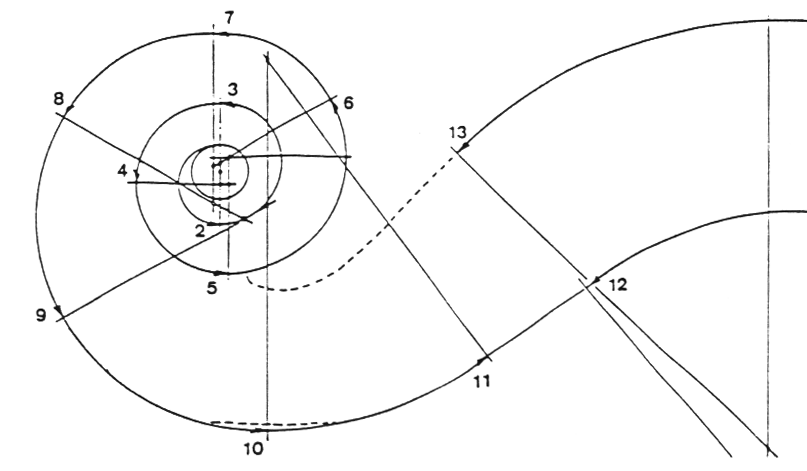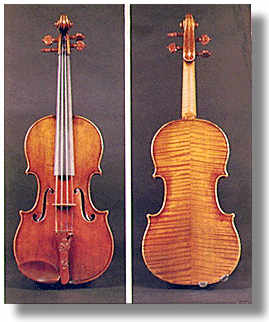 God is the embodiment of wholeness and perfection. Whatever is offered to him should be total and perfect. This was demonstrated by the Italian violin maker Anthony (Stradivarius) who took one year to make one violin, but made it to perfection as an offering to God. Whatever is said, done or given, it should be perfect. To please God, who is perfect, whatever is offered should be perfect. Anthony declared that he was making perfect violins only to please God. (Sathya Sai Baba, 25 Aug 1997)
God is the embodiment of wholeness and perfection. Whatever is offered to him should be total and perfect. This was demonstrated by the Italian violin maker Anthony (Stradivarius) who took one year to make one violin, but made it to perfection as an offering to God. Whatever is said, done or given, it should be perfect. To please God, who is perfect, whatever is offered should be perfect. Anthony declared that he was making perfect violins only to please God. (Sathya Sai Baba, 25 Aug 1997)
Origins
The famous Cremonese violin-maker, b. in 1644; d. at Cremona, 18 or 19 Dec., 1737. He was the son of Alessandro Stradivari and Anna Moroni. As there is no evidence of his birth and baptism in any of the parish registers of Cremona, it is supposed that he was born in some village near that town. In 1667 he began to make stringed instruments. Some violins, dated in the seventies, and signed by him, are supposed to exist, but evidences of Stradivari’s workmanship are to be found in many violins of this date which are signed by Nicholas Amati. In 1666 he claimed to be a pupil in Nicolo Amati’s workshop. A vioin from that year shows a hand already adept in the use of woodcarving tools, though inexperienced in the finer points of violin construction.
Family and Craftsmanship
Stradivari married in July of 1667, to one Francesca Feraboschim, a young widow who bore him six children.
In 1680 Stradivari set up shop for himself in the Piazza San Domenico, and his fame as a violin-maker was soon established. He now began to show his originality, and to make alterations in Amati’s model. The arching was improved, the various degrees of thickness in the wood were more exactly determined, the formation of the scroll altered, and the varnish more highly coloured.
In 1698 Stradivari’s first wife died, and in the following year he married Antonia Maria Zambelli, who bore him five more children.
From 1698 to 1725 Stradivari produced his finest instruments and carried his manufacture to the highest possible finish, the outlines are designed with taste and purity, the wood is rich and carefully selected, the arching falls off in gentle and regular curves, the scroll is carved with great perfection, and the varnish is fine and supple. The interior workmanship is no less perfect, the degrees of thickness are carefully adjusted, and are remarkable for a precision which could only have been attained by much study and experiment.
Everything has been foreseen, calculated, and determined with certainty. The instruments produced from 1725-30 are not so fine. It seems that Stradivari was less easily able to obtain the handsome maple wood. Wood of local origin predominates from this age until 1730. After 1730 many are signed “sub disciplina Stradivarii,” and were probably made by his sons, Omobono and Francesco. Stradivari was buried in the Basilica of San Domenico.
Devotees of God should not mind the criticisms of envious persons. All good people have to face such troubles. They should treat everything as meant for their good. This was how the Pandavas looked upon all the troubles they experienced. Yesterday and today the overseas devotees filled everyone with joy by their music programs. God is a lover of music and enjoys music. Saintly devotees like Narada and Thumburu, who are always in the proximity of God, are always singing the glory of God. Nothing else can give so much joy as music. You can please God with your music. God revels in music. Music is therefore holy. It reflects the state of one’s inner being.
Sets Standards
Stradivari fixed the exact shape and position of the sound-holes, and his model has been copied by most makers since his time. He definitively settled the shape and details of the bridge, which cannot be altered in the slightest degree without in some way injuring the tone of the instrument. The only essential part of the violin which has had to be changed since Stradivari’s time is the bass-bar. On account of the gradual rise in pitch the increased pressure of the strings demands an increased power of resistance in the bar underneath the bridge, hence it has been found necessary to re-bar all the old violins and violoncellos.

An aged violinist who died in 1853 told one scholar that his teacher had known Stradivari and described him as “tall and thin in appearance, and invariably seen in his working costume, which rarely changed, as he was always at work.” It is the only remotely contemporary physical description of Stradivari that we have.
Recovering Stradivarius
In 1902, the brothers Hill–William Henry, Arthur Frederick, and Alfred Ebsworth, scions of a British family that had been in the stringed instrument business for nearly 300 years–produced what remains the benchmark for Stradivari scholarship, Antonio Stradivari: His Life & Work (1644-1737). Expert luthiers (stringed instrument makers), restorers and dealers themselves, the Hills were uniquely qualified to write such a book. Having spent more than a half
century selling rare instruments when such a trade was even more confined than it is today, they personally were familiar with virtually every Stradivari instrument then known to exist: 540 violins, 12 violas, 50 cellos–and two guitars.

Modern Inquiry into Stradivarius
From the Scientific American Website:
Secrets of the Stradivarius: An Interview with Joseph Nagyvary June 10, 2002

(Excerpt)
SA: When a person first hears a Stradivarius, what about its sound makes it so valuable to the trained or the untrained ear?
JN: A Stradivari sound is very lively. It flickers, it constantly trembles, it moves like candlelight. There are some 600 Stradivari’s around, so tone is not uniform–some have a fat sound with a big woof note, and others are more lean. But on average, a Stradivari is a good combination of darkness and also brilliance, a very pure tone.
God Loves Music
In this world there is nothing that you cannot achieve with love. I am the best example for this. Love is My greatest property. I love everybody, but I do not desire anything except love. Here is a small example: Many students are coming here for studies. But this education is not doing any good to the world. All the subjects like Physics, Botany, Chemistry will only help to eke out a livelihood. But none of them can attract the human heart as music does. Even God is attracted by music. Once Narada asked Vishnu, “Swami, You have various branch offices like Vaikunta, Kailasa and Swarga. But I want to know the address of Your head office so that I can contact You without delay.” Vishnu said, “Madbhakthaa Yathra Gayanthi Tathra Thistaami Narada” (you will find Me installed wherever My devotees sing My glory). That is why God is extolled as Ganapriya and Ganalola (lover of music). So, I wanted to start a music college here. But I did not tell anybody about this. I usually do not tell what My plans are. Whatever I Will certainly happens. Last week a devotee by name Puri from Indonesia came here and prayed to Me that I should start a music college here for which, he said, he would donate 10 crores of rupees. The culture of Bharat is contained in music. The modern music too is essential. But along with that Street plays, Harikathas (singing the stories of God) have to be encouraged. Music plays a vital role in fostering Indian culture. Sathya Sai Baba
Listen to a Strad Violin
Can you tell the difference?
Here’s a chance for readers to judge for themselves which sounds better, a genuine Stradivarius or a Nagyvary
instrument. Each pair of songs here is played by concert violinist Zina Schiff, one on her 1697 Stradivarius, one on a Nagyvary violin made in collaboration with luthier Guang Yue Chen in 1991. The identification of the violin used for each movement will eventually be revealed at www.nagyvaryviolins.com
(Click to hear the MP3 files.)
You may listen to J.S. Bach: Sonata No. 1 Adagio:
You may listen to J.S. Bach: Sonata No. 1 Fugue:
You may listen to Stravinsky: Suite Italienne—Serenata:
You may listen to Stravinsky: Suite Italienne—Tarantella:
You may listen to Stravinsky: Suite Italienne—Gavotte:
You may listen to Stravinsky: Suite Italienne—Variations I:
How Many Strads?
Since the Hills, other experts have attributed additional instruments to Stradivari, who employed the Latinized version of his name, Antonius Stradivarius, on his labels. (Scholars use either spelling interchangeably.) Thus the accounting of existing Strads has been inching upward toward 700 or so, a number about which collectors and dealers politely debate. Because the sales of many Strads are conducted privately between a few discreet dealers and well-heeled collectors, the exact number of his surviving instruments is almost impossible to determine.
The Hills meticulously estimated that Stradivari made 1,116 stringed instruments during an extraordinary career that spanned seven decades, from about 1665, when he was 21, to the year he died at the age of 92 or 93. He was, they wrote, “an expeditious worker,” with tremendous “industry and devotion to his art.” They calculated that he was able to complete at least two violins or one cello a month, or an average of 25 violins or 10 cellos a year–and sometimes many more. In 1715, when Stradivari was 71, the king of Poland ordered 12 violins from him and sent his director of court music to Cremona to await completion of the instruments. The king received all 12 in three months.
Sathya Sai Baba tells:
“There should be enquiry into ideal leaders of the past. Ideal means following morality and truth without giving up integrity. Such examples are Rama, Krishna and Jesus. Other ideal leaders in history are Socrates, Alexander the Great, Marco Polo, Antony Stradivarius, George Washington and Florence Nightingale. All these lives show selflessness in pursuit of a greater vision for humanity. By enquiring into the lives of ideal leaders and managers their qualities are reflected in our lives.”
Antonio Stradivari had a way with his violins – a way that has never been duplicated. Although his instruments date from 1666 to 1737, violin makers around the world have since tried to at least come close to reproducing the legendary sound that only a Stradivarius can purportedly make. Antonio Stradivarius probably never wrote a sermon, probably never translated a scripture or expounded on a gospel. Yet, he illustrated that “Work is Worship, duty is God”.
The Instrument Maker and God
Once upon a time in Italy, there lived a person by name Anthony. He used to earn his livelihood by making violins, but being a perfectionist as he was, he used to take one full year to make a violin. His friends chided him saying, “O mad man, how do you expect to eke out your livelihood if you spend a whole year to make one violin? Anthony replied, “God is the embodiment of perfection. Whatever He does is absolutely perfect. He will be pleased only when we discharge our duty in the most perfect manner. All my work will be a utter waste, if God is not satisfied!’
In this context, the Vedas declare: Poornamadah Poornamidam Poomaath Poomamudachyathe Poornasya Poornamaadaaya Poomameva Vasishyathe The perfect whole is the basis. All that is here is the perfect whole. The whole emanates from the whole. When the whole is separated from the whole the perfect wholeness remains perfect as wholeness.
Only through total love can one please Divinity Perfection arises out of love. There is nothing greater than love. No benefit accrues from chanting various names of the Lord without the spring of love in the heart. It is enough even if one name is chanted wholeheartedly and with a feeling of love. All your work must be totally dedicated to God. It should be done with total love and pure heart. This is the essence of Sathyavathi mode of worship. Anthony’s violins were very famous and highly valuable. The reason is that he used to make them with sacred feelings and total devotion. He never felt that he was wasting his time. He always had the feeling that he was sanctifying his time by doing his work perfectly and thus pleasing God. You should follow the ideal of Anthony Sathya Sai Baba

This work previously appeared on narayanaoracle.com and is © Chris Parnell
![]()

